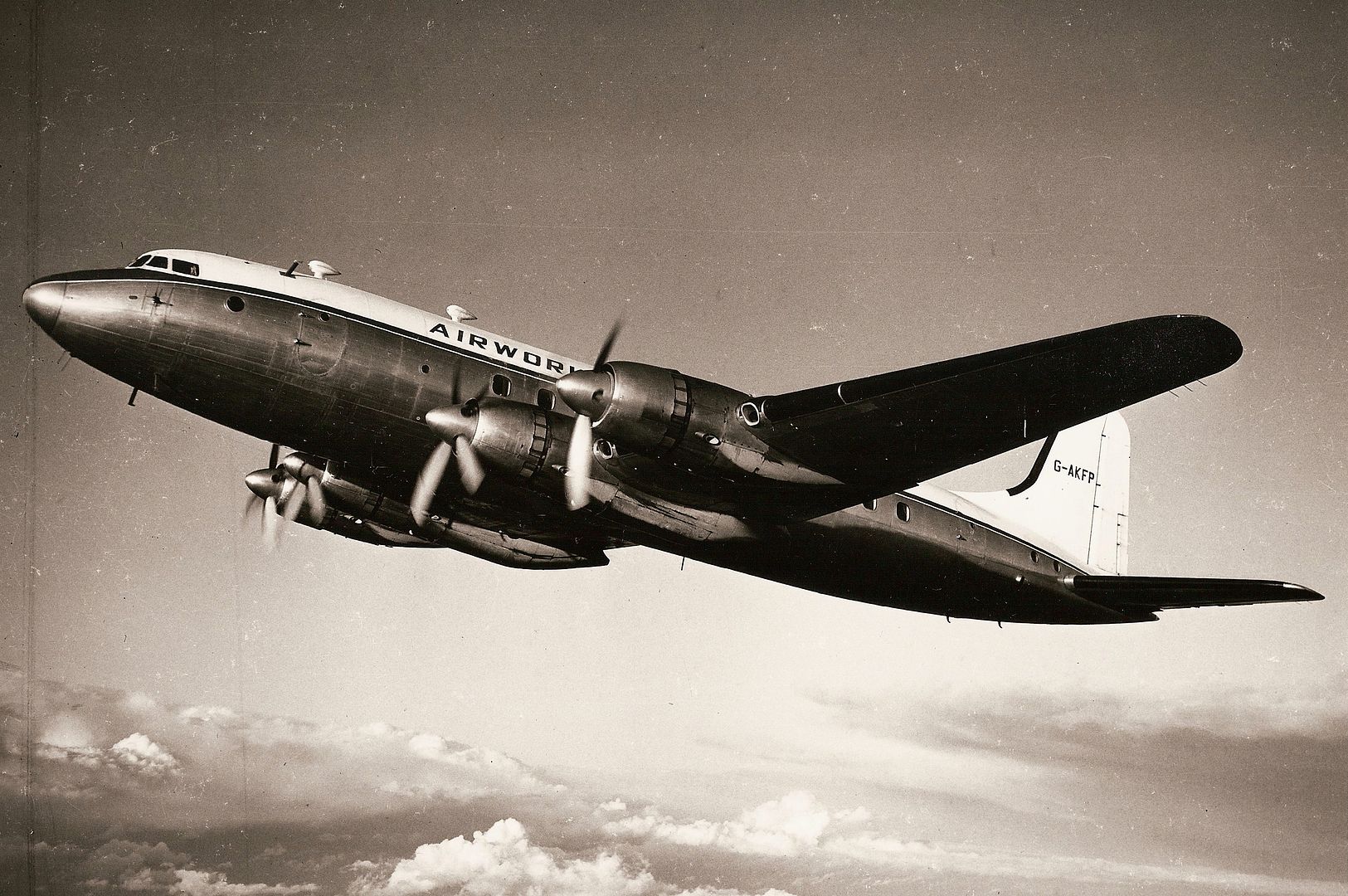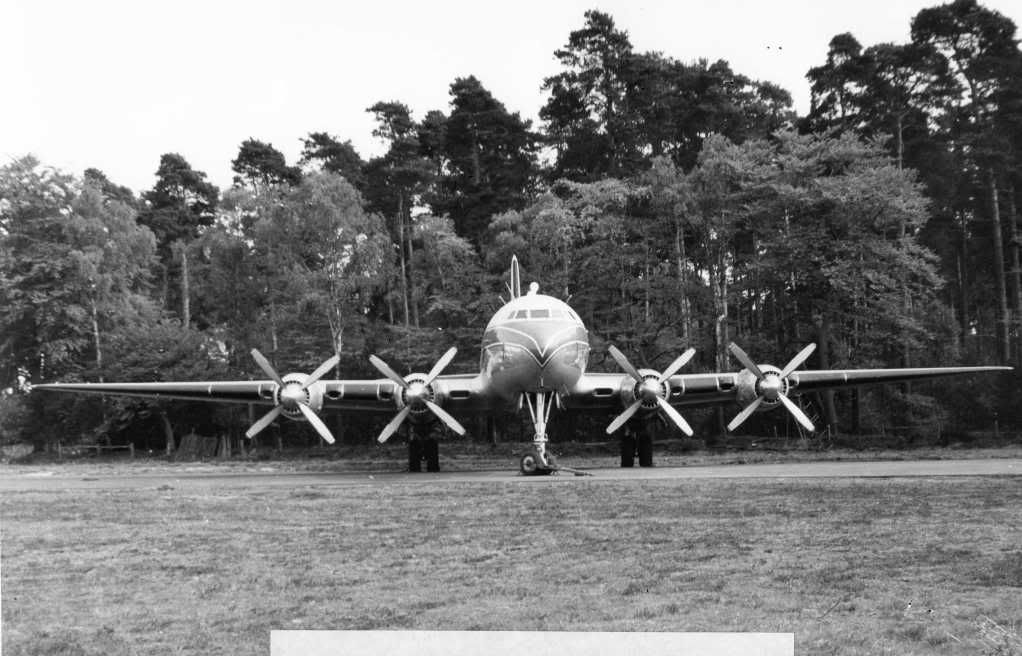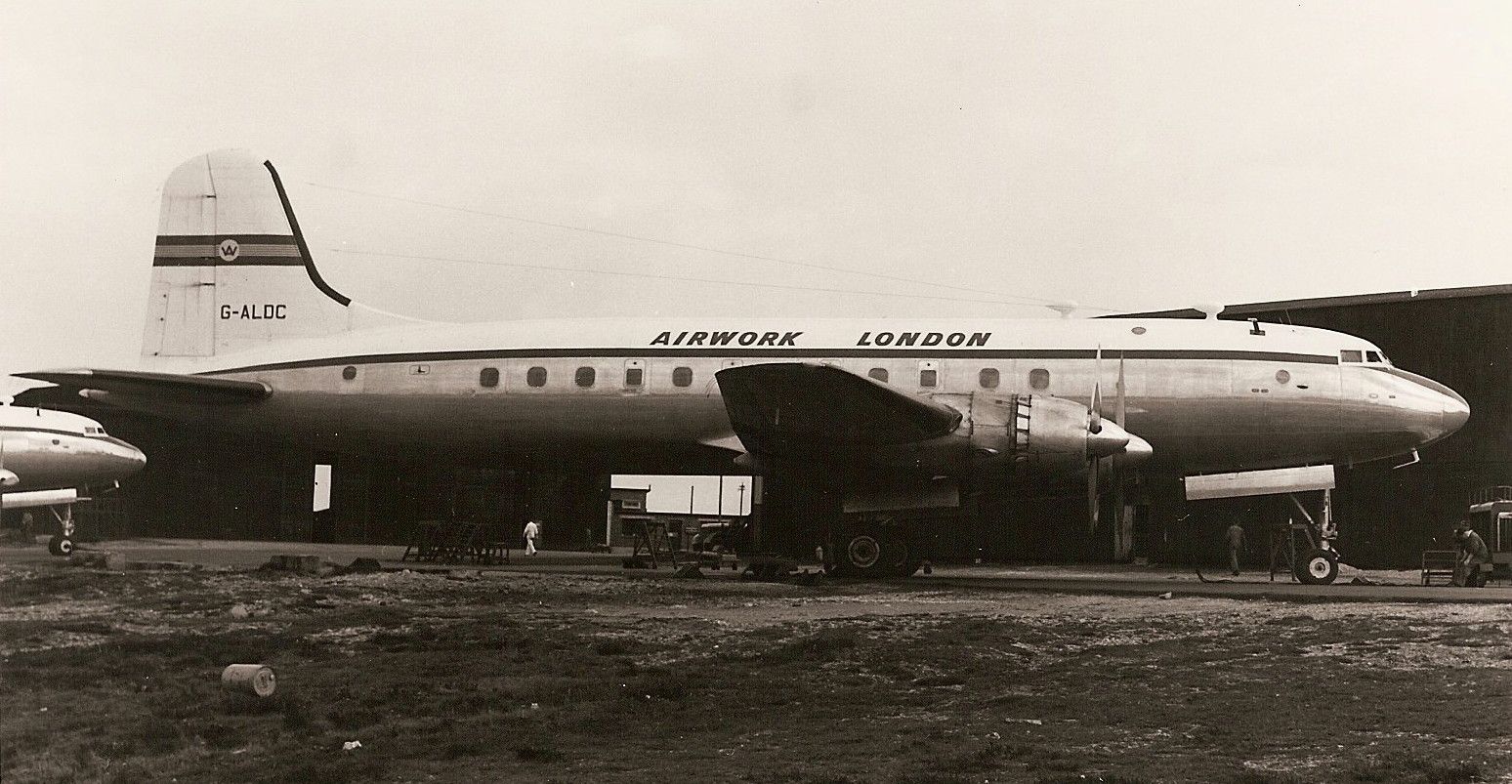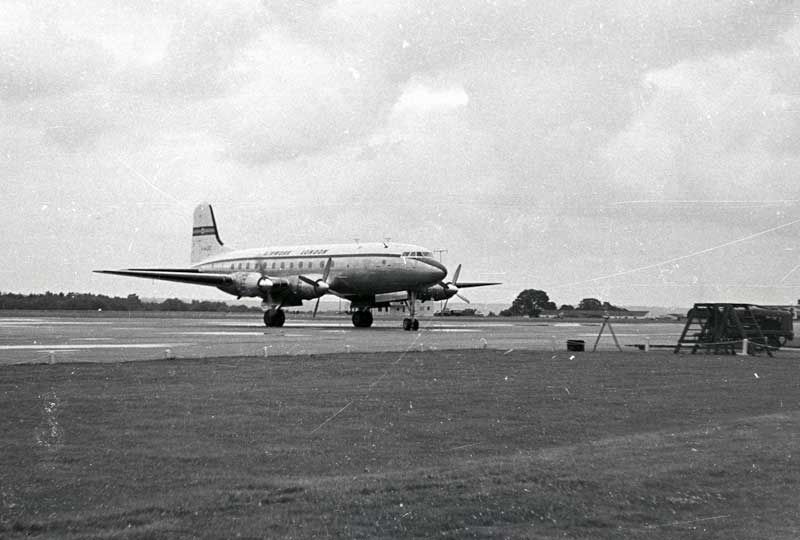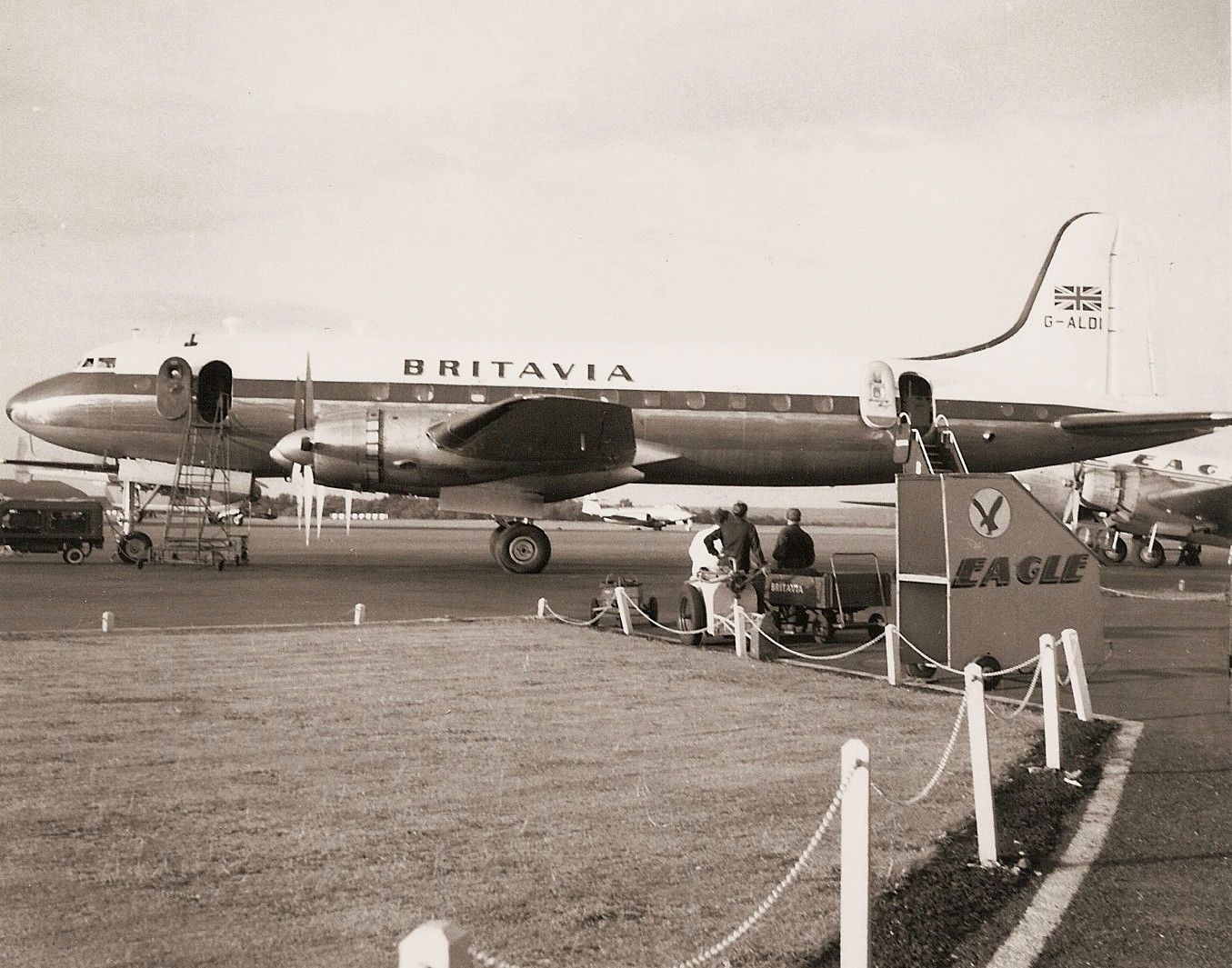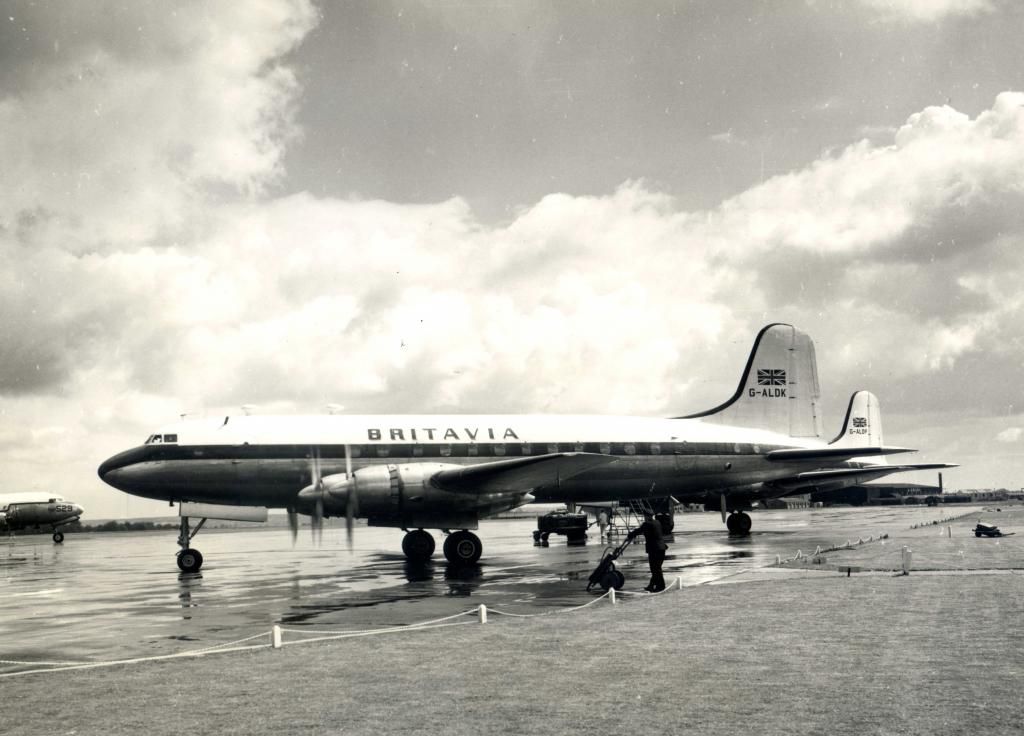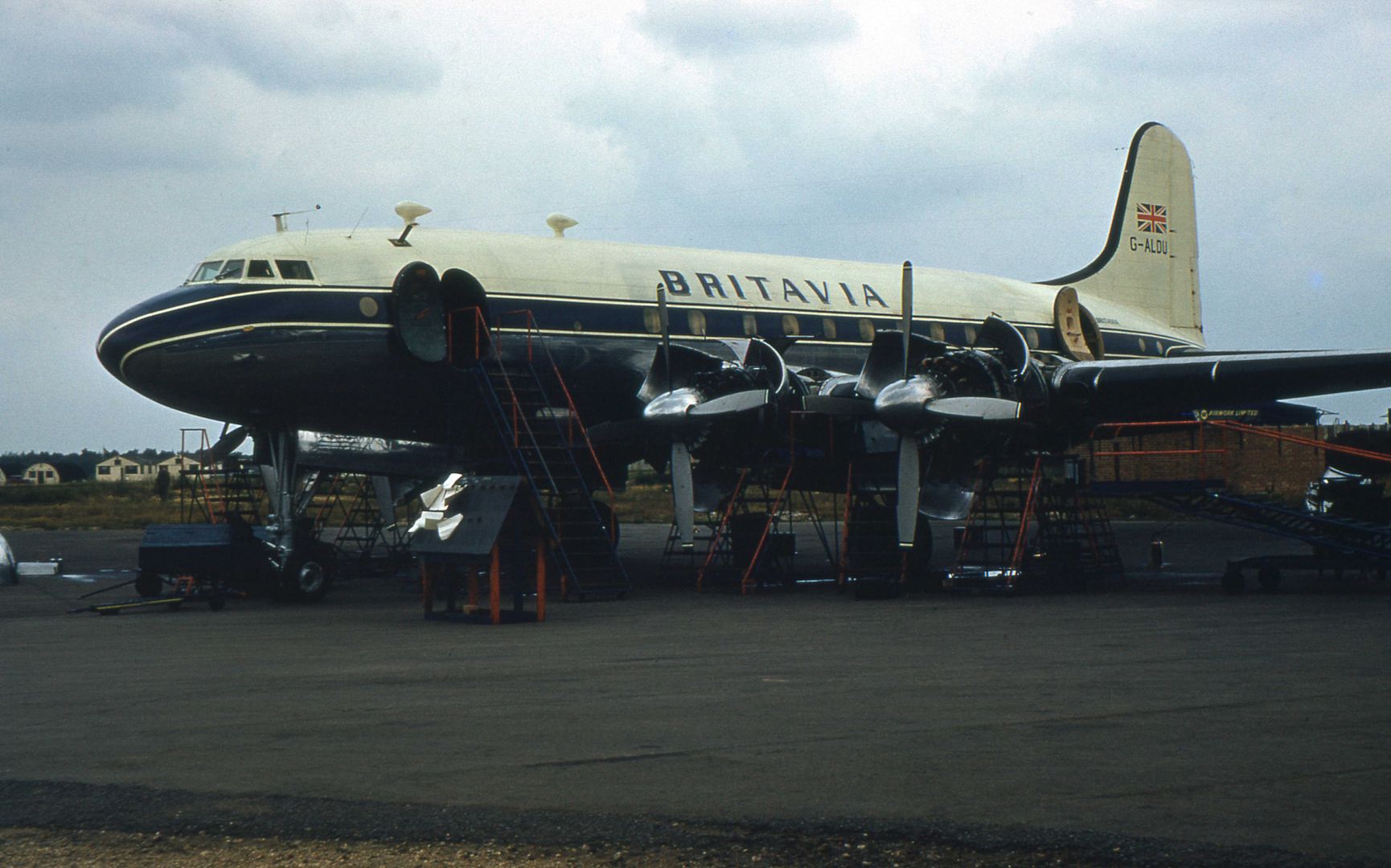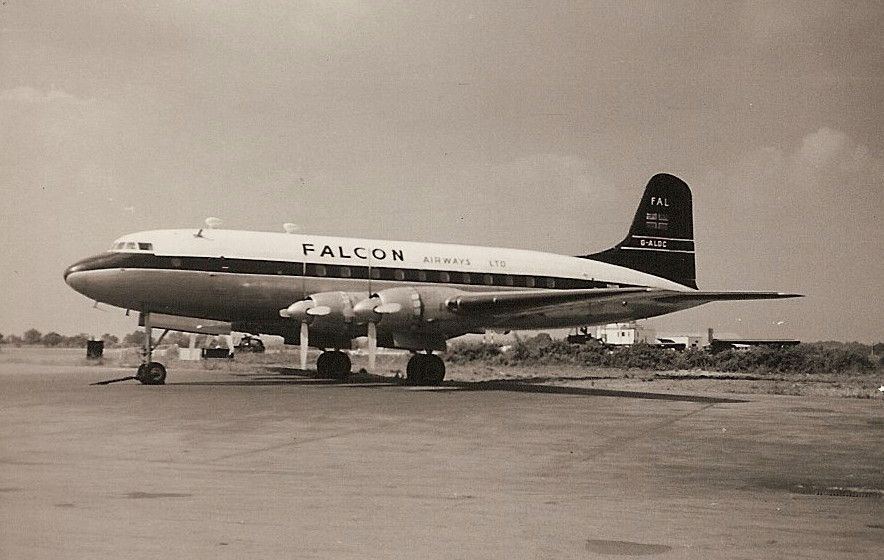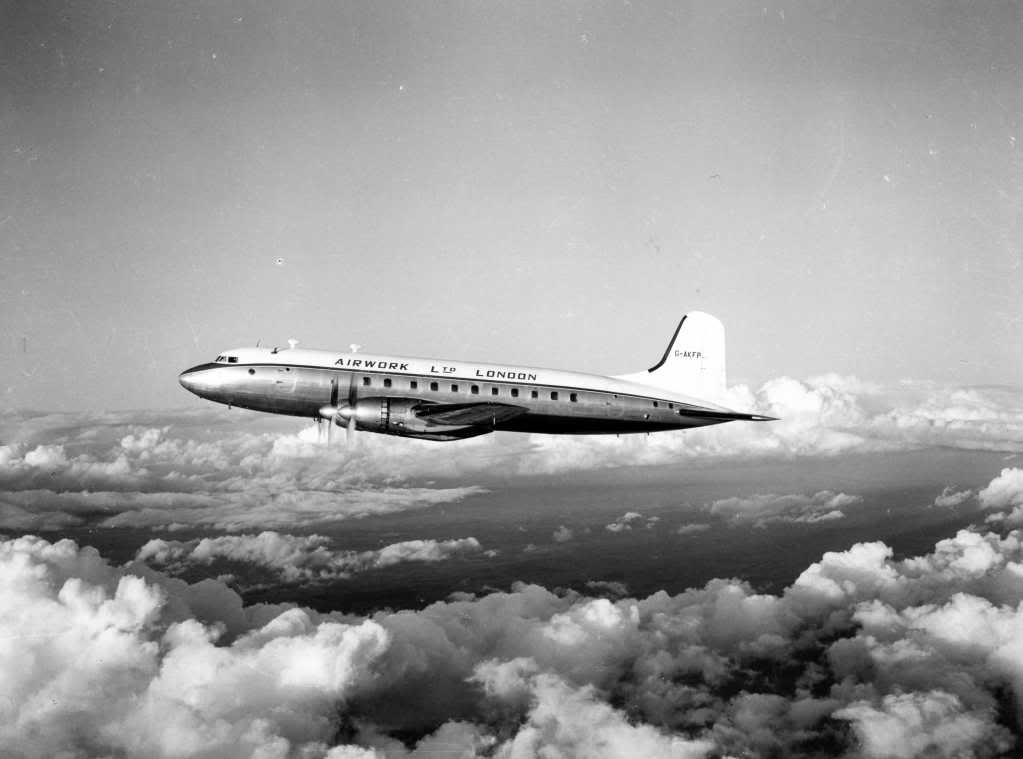Post by flyboy on Mar 4, 2016 23:13:08 GMT
THE HANDLEY PAGE HERMES.
HERMES DEVELOPMENT.
The early days of the Handley Page Hermes were to see many setbacks. Initially it was to be built to meet an RAF specification issued in 1944 for a pressurised transport aircraft suitable for civilian use and designed to carry 34 first class or 50 tourist class passengers. The RAF were keen to replace the HP Halifax which was being used in the transport role at this time. To this end the tail-wheeled HP Hastings was being developed to fill the RAF requirement. The Hermes was planned to have a nose wheeled undercarriage but the first two prototypes were built with tail wheels.
The first of these designated as the HP.68 Hermes 1 was a very basic aircraft powered by four Bristol Hercules 101 radial engines of 1650 hp (1249Kw). Registered G-AGSS it made it's maiden flight on Sunday 2nd December 1945 but crashed shortly after take-off from the company airfield at Radlett, killing the company chief test pilot and the observer.
The official report into the accident considered that the cause was a direct result of elevator overbalance which caused the pilot to lose control. The aircraft had been seen to porpoise before entering a sudden climb which could not be satisfactorily explained. At different trim settings a reversal of stick forces would have occurred with which the pilot would have been unable to keep in phase as the loads increased.
This crash and the pressure to build the Hastings were the cause of a lengthy delay before the second prototype made it's first flight. Designated the HP.74 Hermes II and registered G-AGUB, later VX234, it was pressurised and lengthened 13 ft (4.57m) with four Bristol Hercules 121 engines of 1675hp (1249 Kw) and eventually flew on 2nd September 1947. It was used for testing airborne radars at the Royal Radar Establishment at RAF Defford and was finally retired in 1969 - the last of the flying Hermes.
The HP.81 Hermes IV prototype G-AKFP made its first flight on 5th September 1948. This was the version that was ordered by BOAC as a high speed piston engine airliner, intended for medium to long-range work with a cruising speed of 290 mph. It would carry a 7 ton payload in excess of 3500 miles and the BOAC machines would carry 40 passengers in exceptional comfort although the aircraft had been designed to carry 74 passengers. The airline introduced the aircraft into service in early August 1950.
This was the version of the Hermes, with the IVA, that was to serve the independent airlines in the future as BOAC disposed of them in favour of the Canadair Argonaut in 1952 after only a short period of service. Some were ,however, recalled to service for a short while due to the Comet crisis
The Hermes IVA was a modified Hermes IV fitted with the Hercules 773 engine which could run on a lower octane fuel. Aviation fuel was often difficult to obtain at this time, especially higher grade when abroad, and it was therefore an advantage to be able to use a lower grade fuel. However many of the aircraft were re-engine again with the Hercules 763's when fuel supplies improved and were returned to IV standard.
The HP.82 Hermes was the next development with two prototypes being built fitted with Bristol Thesus turboprop engines. The HP.82 never entered production and one crashed at Chilbolton on 10.4.51 while the other went to Boscombe Down and then to Farnborough for test flying being finally retired in September 1953. This aircraft registered G-ALEU appeared at the 1950 Farnborough Airshow.
The last Hermes to fly in civilian hands was G-ALDA of Air Links which was retired on 13th December 1964 and was scrapped only nine days later.
The fuselage of the formally operated BOAC machine G-ALDG, which was once used as a cabin crew trainer by Air Caledonia at Gatwick can now be viewed at the IWM Duxford. Being a fuselage only, less wings, engines, and other components it does at least still survive!
HERMES IV SPECIFICATION
Crew 7
Passengers 40 - 82
Wingspan 113' (34.45m)
Length 96' 10" (29.52m)
Height 30' (9.15m)
Wt Empty 55350 lb (25159 Kg)
MTOW 86000lb (39092 Kg)
Power 4x Bristol Hercules 763 radial engines 2100hp (1566Kw)
Max speed 350mph (567 Km/h)
Cruise speed 270mph (437 Km/h)
Range 2000 m (3242 Km) with 14125lb (6420 Kg) payload
Ceiling 24500' (7470m)
Climb rate 1030' per min. (314 m/min)
HERMES OPERATING COMPANIES BASED BLACKBUSHE.
AIRWORK
Having been founded in 1928, by June 1936 Airwork were heavily involved in RAF training and support of the Air Ministry's maintenance operations which was to continued throughout World War II. The company was involved with the training of tens of thousands of pilots and also held Government engineering contracts. After the war a new site at Blackbushe was selected from where aircraft overhaul and aircraft sales was conducted. It became part of the British and Commonwealth Group of Companies and post war expanded into civil aviation. Charter flights were primarily operated from Blackbushe. Inclusive tour flights for the UK Civil Service and Muslim hajj flights to and from Jeddah soon followed and the company were involved in the Berlin Airlift. Airwork were the first company to undertake trooping flights for the War Office but the Hermes used suffered a number of engine faults. There were a number of crashes and mishaps which resulted in the loss of the trooping flight monopoly. By 1957 Airwork in conjunction with Hunting-Clan were operating to run third class scheduled flights to Africa with traffic being shared with BOAC. In 1958 Airwork and Hunting-Clan merged into British United Airways. However, by july 1960 Airwork was still flying it's Hermes between the UK and West Africa for Gold Coast Chamber of Mines.
Aircraft operated included:
G-AKFP, G-ALDA, G-ALDC, G-ALDF, G-ALDG and G-ALDO.
..................................................................................
BRITAVIA
British Aviation Services Ltd ,Britavia, one of the first post-war airlines was formed in 1946 and moved into Blackbushe in 1947. It wasn't until 1954 that the airline was formed, the company previously having concentrated on aviation consultancy and aircraft ferrying work. The airline operated trooping and ad-hoc charter flights with four Hermes aircraft but were to lose two aircraft involved in accidents in 1956, one of which was replaced. They had a large hangar situated in the south-east corner of the airfield to the south of the A30 road crossing point. Trooping flights continued until 1958 at which time their Hermes fleet of aircraft were merged with Silver City and the aircraft moved to join the company Manston operation.
Aircraft operated included:
G-ALDI,G-ALDJ, G-ALDK, G-ALDM, G-ALDP, G-ALDU and G-ALDX.
................................................................................
FALCON AIRWAYS
Falcon Airways was formed by Captain Kozubski and operated charter flights from Blackbushe and Hurn. In October 1959 the airline acquired three Hermes but almost immediately sold one in the following December. In 1960 the airline moved to Gatwick but one of their aircraft crashed in October when G-ALDC over-ran the runway on landing at Southend and ended up on the Shenfield to Southend railway line. Of the 76 persons on board five were injured and taken to hospital. The remaining aircraft was then sold to Air Safaris. The airlines operating certificate was withdrawn by the British authorities in 1961 and the airline ceased to operate.
Aircraft operated included:
G-ALDA,G-ALDC + 1.
*********************************************
HERMES OPERATED AT BLACKBUSHE BY NON-BASED COMPANIES.
BRITISH OVERSEAS AIRWAYS CORPORATION
The airline ordered 25 Hermes IV on the 4th February 1947 but initially rejected delivery as the aircraft were found to be too heavy. They were finally accepted and entered service on 6th August 1950 replacing Avro Yorks on the West African services. This was short lived as the aircraft were withdrawn in favour of the Canadair Argonaut in 1952 and put up for sale but some were to return to service in July with the grounding of the early Comets. BOAC finally disposed of the fleet to independent charter airlines such as Airwork who initially mainly used them on trooping flights.
Aircraft fleet:
G-ALDA to G-ALDY
...............................................................................
AIR SAFARIS
Scheduled and charter flights using Hermes and Vikings had started in 1952 as Meredith Air Transport. In 1954 the airline changed it's name to become African Air Safaris Ltd and purchased an ex BOAC Hermes in 1956 plus the two Vikings in 1959. The company Air Safaris was founded in 1959 operating from Gatwick. In 1960 they acquired the transport division of Don Everall Aviation and commenced operating scheduled flights from Birmingham, with a maintenance base at Hurn being set up in 1961. They ran into financial difficulties later that year and ceased operating on 2nd November at which time they had an aircraft fleet of five Hermes and eight Vikings plus 200 employees. Following a creditors meeting on the 29th January 1962 the company folded with official receivers being called in and the assets liquidated.
Aircraft fleet:
Little known but G-ALDM of Britavia was used in August 1957 and between April and November 1958.
...............................................................................
SKYWAYS
Was formed in 1946 and soon became the largest operator of non scheduled air services throughout Europe. It was in 1954 that the airline purchased ten ex BOAC Hermes for use on trooping and general charter work. The company received a £1.5m contract to transport 12000 troops between the UK and Cyprus. In 1955 the Coach-Air service between London and Paris was launched followed in 1957 by BOAC awarding a contract to operate regular freight services between Heathrow and Singapore. In 1959 the airline expanded into the Carribean with the acquisition of an 80% stake in Bahamas Airways from BOAC. Two Hermes with completely refurbished interiors were allocated to the new venture but it did not appeal to the mainly US-based clientele and with mounting losses the aircraft were allocated to a new scheduled service being launched between Heathrow and Tunis. Heathrow became the airlines main operating base but by 1961 most of the Hermes flee had been disposed of and all passenger flights were undertaken by leased Lockheed Constellations. Skyways Ltd eventually became a wholly owned subsidiary of Euravia in 1963.
Aircraft Fleet:
G-ALDD, G-ALDE, G-ALDH, G-ALDS, G-ALDT, G-ALDV, G-ALDW and G-ALDY.
On 4th March 1956 the airline lost G-ALDW which was destroyed by a time bomb on the ground at Nicosia, Cyprus just 20 minutes before take-off to the UK with 68 passengers due to fly. Non were injured but the aircraft was destroyed.
On 4th April 1958 Hermes G-ALDV crashed near Stansted while on an air-test following an engine change killing all three crew.
..............................................................................
SILVER CITY AIRWAYS
Silver City had established a large maintenance base at Blackbushe in 1946 with their fleet of Lancastrians and Dakotas being serviced from 1947 onwards. They also attended to aircraft maintenance on other operators aircraft. It was, however, their associated company Britavia that operated their fleet of six ex BOAC Hermes from Blackbushe on long range trooping and charter flights, which included the types first ever trans Atlantic flight on 14th November 1955.
The aircraft were subsequently transferred back to fly with Silver City titles when the 'Silver Arrows' service was started in the mid 1950's on the Manston to Paris route. Manston had been selected as the new base as the Hermes were too large to operate from the company base-airfield at Ferryfield. Losses in the 1960 and 1961 seasons, due to price cutting, forced British Aviation Services (BAS), which was the Silver City parent company, to sell out to the P&O Group who formed a new company Air Holdings Ltd which in turn took over the BAS operation. Silver City then ceased to exist after 13 years of operation.
Aircraft Fleet operated in association with Britavia but later carried Silver City markings:
G-ALDM, G-ALDI, G-ALDP, G-ALDG and G-ALDU.
**********************************************
OTHER HERMES OPERATORS THAT DID NOT VISIT BLACKBUSHE
AIR LINKS
BAHAMAS AIRWAYS & AIR BAHAMAS
MIDDLE EAST AIRLINES
KUWAIT AIRWAYS
ROYAL RADAR ESTABLISHMENT
MINISTRY of SUPPLY
**********************************************
HERMES NOTED AT BLACKBUSHE
( Where dates shown in block ie 1.2.59 to 3.4.60 indicates aircraft noted between these dates).
Reg c/n Operator Dates Noted BB Notes
G-AKFP HP.81/1, AIRWORK 11.9.54 to 7.6.57, Written Off 1.9.57
G-ALDA, HP.81/2, AIRWORK 30.5.53 to 1.11.59, 2.8.59 to 1.11.59 for sale.
FALCON AW 1.11.59 to 29.11.59
AIRWORK 23.12.59
FALCON AW 14.5.60 To Gatwick,(Later with Air Links,
not seen BB, Scrapped '65).
G-ALDB HP.81/3, AIRWORK 30.5.52 Written Off 23.7.52
G-ALDC HP.81/4, AIRWORK 2.8.52 to 9.4.59 Ex BOAC 'Hermione'
FALCON AW 6.6.59 to 12.4.60 To Gatwick, Written Off Southend
9.10.60 (Crashed onto railway).
G-ALDD HP.81/5 SKYWAYS 29.8.56
G-ALDE HP.81/6 SKYWAYS 10.8.56 to 29.12.58 Ex BOAC 'Hanno', To VP-BBO
Bahamas Airways.
G-ALDF HP.81/7 AIRWORK 05.52 Written Off 25.8.52
G-ALDG HP.81/8 AIRWORK 23.4.55 to 29.8.59 Ex BOAC 'Horsa', 3.11.58 For
Sale, 17.11.58 leased BOAC.
G-ALDH HP.81/9 SKYWAYS 10.8.56 to 21.3.59
G-ALDI HP.81/10 BRITAVIA 19.6.54 to 21.12.55, Ex BOAC 'Hanibal', Used Silver City
1.8.59 to 23.8.59 at
Manston, Returned to Britavia
23.8.59.
G-ALDJ HP.81/11 BRITAVIA 25.5.54, Ex BOAC 'Hengist', Landed
Short 06/Crashed 5.11.56,
7 killed.
G-ALDK HP.81/12 BRITAVIA 3.6.54 to 19.4.56 Nose undercarriage collapsed
Karachi 5.8.56.
G-ALDL HP.81/13 BOAC 29.12.55
G-ALDM HP.81/14 BRITAVIA 15.4.56 to 11.10.57 Ex BOAC 'Hero', Used by Air
Safaris August 1957,
AIR SAFARIS 9.4.58 to 3.11.58.
G-ALDN HP.81/15 BOAC Not Seen BB BOAC 'Horus', Crashed Sahara
26.5.52 1 killed.
G-ALDO HP.81/16 AIRWORK 3.9.56 to 21.3.59 Scrapped on N Side
G-ALDP HP.81/17 BRITAVIA 4.9.54 to 4.11.57 Noted 25.5.59 as Silver City
crew training.
G-ALDR HP.81/18 Nothing known about this aircraft.
G-ALDS HP.81/19 SKYWAYS 13.3.55 to 4.9.57
G-ALDT HP.81/20 SKYWAYS 30.1.55 to 14.2.58 Ex BOAC 'Hestia', To VP-BBQ
then to OD-ACB.
G-ALDU HP.81/21 BRITAVIA 18.5.54 to 9.7.59 Silver City charter 8.7.59 to
9.7.59.
G-ALDV HP.81/22 SKYWAYS Not seen BB Crashed near Stansted 1.4.58
G-ALDW HP.81/23 SKYWAYS 3.5.54 to 15.5.55 Destroyed by time bomb 20 min
prior to take-off at Nicosia,
Cyprus 4.3.56. No injuries.
G-ALDX HP.81/24 BRITAVIA 13.6.54 to 30.12.59 Silver City 30.5.59 to 1.7.59,
Scrapped 30.12.59.
G-ALDY HP.81/25 SKYWAYS 10.8.56 Ex BOAC 'Honor', To OD-ACC.
***************************************
CREDITS
PB for the photographs.
rj for the movement details, Watch out for his new book. Coming soon.
internet for much of the information! flyboy 9.3.2016.

